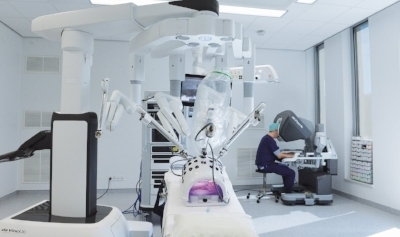Inguinal hernia repair
What is it?
What is it?Types of treatment
Although there are several different techniques to repair an inguinal hernia without using a prosthesis (also called a ‘mesh’), the current guidelines from the European Association for Abomdinal Wall Surgery (EHSS) say that an inguinal hernia in an adult is best repaired by placing an abomdinal wall prosthesis. The most important reason for this is that fewer patients will have a recurrence of the hernia in the long term.
Placing a prosthesis to strengthen the abomdinal wall in the groin can be done using the classic technique (an open procedure with an incision in the groin) or laparoscopically (using an keyhole surgery with three small incisions). At the Maria Middelares Hernia Centre in Ghent, we usually opt for laparoscopic hernia repair surgery or a keyhole surgery. There is sometimes a good reason to perform this intervention as a classic surgery, and the surgeon will also discuss this with you during the pre-operative consultation.
Since 2009, we have used a self-fixing mesh developed by Dr Philippe Chastan in Bordaux (ProGrip®) for an inguinal hernia repair. This mesh has small grips similar to a Velcro® system that can bind on to the tissues. When this is used, we do not need to use painful sutures or staples to keep the mesh in place. Your surgeon can show you the mesh at the pre-operative consultation if you like.
Laparoscopic repair of an inguinal hernia
For a laparoscopic, or keyhole, surgery, the surgeon uses a scope with a video camera and special instruments in order to place a mesh and thus repair the hernia, without needing to make a large incision. The mesh is placed laparoscopically right in front of the peritoneum, after first returning the inguinal hernia inwards. At the Maria Middelares Hernia Centre in Ghent, we opt for the laparoscopic technique because of reduced post-operative pain and a quicker recovery.

Robot-assisted laparoscopic inguinal hernia repair
In September 2016, the Maria Middelares Hernia Centre in Ghent was the first European centre to offer robot-assisted laparoscopic hernia repair. This was started after extensive training in the States, where 8% of all inguinial hernia repair procedures in adults are robot-assisted. The procedure is essentially the same as the traditional laparoscopy, but the instruments and the camera are operated by the surgeon from a console. At the Maria Middelares Hernia Centre in Ghent, we use the latest generation of the Intuitive DaVinci Xi robot. Dr Muysoms now trains European surgeons in this latest innovation in abdominal wall surgery.
Open inguinal hernia repair
At the Maria Middelares Hernia Centre in Ghent, we mostly use the Lichtenstein tehcnique for open repairs. When this technique is used, the groin is reinforced by placing a mesh through an incision and over the groin. For large inguinal hernias, that are presenting on both sides, the Stoppa technique is sometimes used. A midline incision is made and a large mesh that covers both sides of the groin is placed. The open inguinal hernia repair techniques, however, constitute a small minority of the total number of inguinal hernias that we repair at the Maria Middelares Hernia Centre in Ghent.
Possible complications
Possible complicationsAn inguinal hernia operation is generally a safe procedure. Serious complications are rare. Possible complications are listed below. This is not an exhaustive list, but it contains the most frequent complications:
- Bleeding, wound infection and the development of wounds.
- Bleeding in the abdominal wall or groin; this sometimes requires another operation.
- Infection of the prosthesis.
- Accidental injury of the bowel or other abdominal organ, the bladder, for example.
- Switch from keyhole surgery to an open procedure.
- Complications that are not directly caused by the surgery: pneumonia, bladder infection, heart rhythm disorders, etcetera.
- Complications associated with general or epidural anaesthesia.
- Over the long term, the surgical site will remain painful for some patients.
Side effects
Some side effects occur very frequently but are no reason for concern:
- Fluid accumulation
After the operation, a swelling often remains for a few weeks where the umbilical hernia was located. This is fluid accumulation (also termed seroma) that usually is not painful but often causes patients concern. This swelling is a normal side effect of the operation. It will slowly disappear of its own accord. If, in exceptional cases, the fluid accumulation causes pain, the surgeon may decide to drain it.
- Bruise
Another common side effect is bruising around the wound. This is no cause for concern either, and it will spontaneously disappear in the weeks following the operation. In case of doubt or concern, feel free to contact your GP or our department.
Can an inguinal hernia recur?
When a mesh is placed, the chances of a recurrent or another incidence on the same side as the inguinal hernia repair is extremely rare. The percentage is approximately 1-3% in the first ten years after the operation. If you have a inguinal hernia repair on one side, you have approximately 10% chance of developing an inguinal hernia on the other side in the next ten years.
Guidelines for at home
Guidelines for at homeInguinal hernia repairs can be performed in the day clinic for most patients. If necessary, admission for one night will be arranged. We would like you to be active and move around a lot as soon as possible after the operation. We do recommend you avoid lifting heavy loads and strenuous sport activities for three weeks after the procedure.
When you are discharged from the hospital, we will ask you to visit your GP ten days after the procedure to have your wound checked. For keyhole surgeries, your GP will remove the sutures. You may always contact your GP or our department with problems.
A three-week follow-up appointment will be scheduled with the surgeon who performed your operation. After these three weeks, you may resume all your activities, including lifting and sports.
How much does a inguinal hernia repair cost?
How much does a inguinal hernia repair cost?The Maria Middelares Hernia Centre in Ghent charges the official RIZIV prices. The invoice will be sent to you by post after a period of approximately three months. In addition to the surgeon's and anaesthesiologist's fee, this will display the general charges for hospital admission and the use of materials such as the mesh.
As is the case in almost any hospital, there is an additional charge for the use of a single room. At the Maria Middelares General Hospital in Ghent, this additional charge is a maximum of 150% of the official price. No additional charges are added to the fee if a multiple-occupancy room is chosen.
Centres and specialist areas
Centres and specialist areasLatest publication date: 15/12/2023




